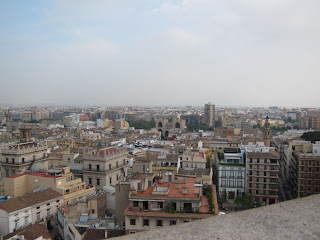Münzer in Valencia – 2:
The Silk Exchange, or Llotja: “ Presently they are building a magnificent building, which they call Llotja, where all the merchants meet to conduct their business. It is a high structure, constructed of cut stone and slender columns. Its width is thirty-two paces, and its length seventy-two. It is completed up to the roof, which will also soon be finished. It has a garden with various fruits and a running fountain. It also has a very high tower, with a chapel, where masses are said daily.”
Pottery Production: “They have a type of mud or potter’s clay that is not found anywhere else, with it they make pots so big that you would think they were wine vats; three or four of the buckets we call "eimers" can fit in them.
They also make plates, jars, pitchers, and many bowls of this type, and they color them so delicately, that you would think them decorated with gold or silver, all of which they sell and ship entire boatloads of them to Venice, Florence, Seville, Portugal, Avignon, Lyons, etc. There are numerous potters.”
The Courtesy of Valencians: “The Valencian population is very affable and courteous. Two Dukes live there, one of which is a son of Pope Alexander VI; many counts, like the Counts of Oliva and Aversa, and various others; more than five hundred knights of the military arm, and many others. There are over two thousand merchants, mechanics and clerics. The men wear long robes, and the ladies dress with more exaggeration than is seemly. In front, their necklines are low cut to their breasts…. All paint their faces, and daub themselves with oils and perfumed waters, with detestable results.
It is also their custom for the inhabitants of the city, both men and women to stroll around from evening until late at night, in such crowds that you would think you were at a fair. However nobody bothers anyone else.”
What Münzer Saw in Valencia:
Münzer gives detailed accounts of events of things long vanished. To paraphrase, he witnessed a sale of “Guanches,” newly-conquered but non-converted Canary Islanders, who were being auctioned off there. He saw “Marranos,” (or “conversos”), awaiting execution for reverting to Judaism, as well as “Sambenitos” (penitential garments) of convicted “conversos” hung in several monasteries. He visited a madhouse. He saw sugar production, furniture manufacture, wine for exportation and a great variety of produce from the surrounding planes, the cultivating mostly being done by Muslims.
Valencian pottery—the gilt-appearing lusterware, was a huge industry of high-end production that was exported all over Europe; many royal families ordered complete sets of dinnerware. Production was generally in the nearby town, Manises, and most of the workmen were resident Muslims, or mudéjares.
The markets, if anything, show even a greater variety of produce, sausages port, beef, veal and poultry than in Münzer’s time, because of modern refrigerated transportation , though even at that earlier date, the amount of import and export was astonishing.
What Münzer never saw:
As at Barcelona, a large modern city has grown up around the small medieval one, with the usual apartment blocks, rail stations, bullrings, etc. Within the old city are also later buildings, a plethora of upscale and humbler restaurants, and plazas where skateboarders practice their skills. You can see this clearly from the top of the Cathedral belltower; not only the great city beyond the medieval inner old town, but the number of newer buildings mixed in with the old monuments in the oldest sections. People are still out late, and stores stay open late. When we were there, there were strong anti-government protests among the local population. In addition, much as in Barcelona, graffiti has become an approved public art form.








No comments:
Post a Comment